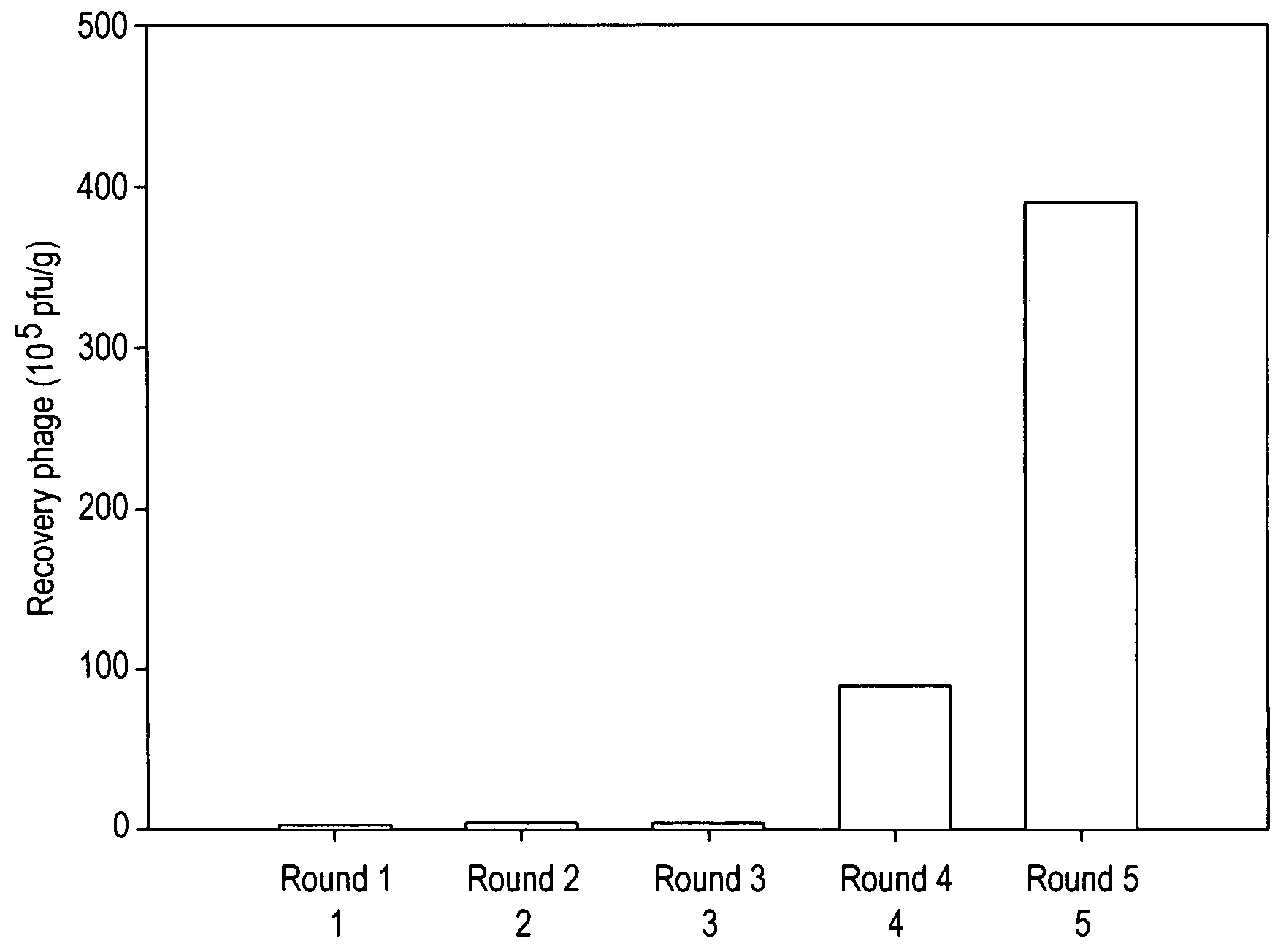Peptides that target to tumor blood vessels of lung cancer and applications thereof
a technology of lung cancer and tumor blood vessels, applied in the direction of peptide/protein ingredients, depsipeptides, liposomal delivery, etc., can solve the problems of narrow therapeutic index, limited therapeutic index, and limited access to the host vascular system
- Summary
- Abstract
- Description
- Claims
- Application Information
AI Technical Summary
Benefits of technology
Problems solved by technology
Method used
Image
Examples
example 1
In Vivo Phage Display Biopanning Procedures
[0153]CL1-5, H460, and PC3 were grown in RPMI 1640 supplemented with 2 g bicarbonate, 40 mg kanamycin per liter, 2 mM L-glutamine, and 10% fetal bovine serum (FCS, Gibco, Calif., USA) at 37° C. under a humidified atmosphere of 95% air and 5% CO2 (v / v). CL1-5 was established by Chu et al. (Chu et al., 1997). SAS, HCT116, BT483, Mahlavu and PaCa were grown in DMEM (Gibco, CA, USA) containing 3.7 g bicarbonate, 40 mg kanamycin per liter, 2 mM L-glutamine, 5% FCS, and incubated in 10% CO2 incubator. HUVECs were isolated from the umbilical vein after separation from the placenta and grown in M199 medium (Gibco, CA, USA) supplemented with 20% FCS, antibiotics, 15 μg / ml endothelial growth factors (upstate, NY, USA), and incubated in a 5% CO2 incubator.
[0154]To isolate tumor-homing phages from tumor tissues we used a phage displayed peptide library to treat the NSCLC (CL1-5) tumor-bearing mice for five rounds of in vivo selection (biopanning). SCID...
example 2
In vivo Homing and Peptide Binding in Xenograft Tumor Vessels
[0157]To investigate the targeting ability of PC5-52, phages were injected into the tail vein of SCID mice bearing human lung cancer cell-derived tumors and recovered after perfusion. We determined the titers of the phages in tumor mass and other normal organs. The phage clones, or control helper phage (insertless phage), were injected into the tail vein (i.v.) of SCID mice bearing human lung cancer tumor xenografts for 8 min or 24 h. After perfusion, xenograft tumors and organs were removed and the recovered phage titered. In peptide competitive inhibition experiments, described below, phage clones were co-injected with 100 μig synthetic peptide. After injection of candidate or control phage clones, the organs and tumors were removed and divided into two parts. One part was titered by ER2738, and another part was embedded in Optimal Cutting Temperature (OCT, Tissue-Tek, NL, USA). The OCT-embedded frozen tissues were secti...
example 3
Localization of PC5-52 and SP5-52
[0161]To investigate the homing specificity of PC5-52, we used an immunofluorescent assay to localize the binding activity of the phage after perfusion. Human lung adenocarcinoma frozen sections were prepared as above. The slides were incubated in blocking buffer for 30 min, and then treated with 3% hydrogen peroxide plus 0.1% NaN3 in methanol to block endogenous peroxidase activity, and incubated with biotin-labeled peptide. The slides were subjected to routine immunohistochemical staining.
[0162]The results showed that phage particles reacted with xenograft tumor sections of lung cancer but not with normal lung tissues (FIG. 3A). However, the phage did not localize to cancer cells. Tumor masses appear in panel (a), while normal lung appears in panel (c). Panels (b) and (d) are counter stained for nuclear DNA with H33258, and correspond to panels (a) and (c), respectively. When we used frozen sections from tumor tissues that were incubated with anti-...
PUM
| Property | Measurement | Unit |
|---|---|---|
| diameters | aaaaa | aaaaa |
| diameter | aaaaa | aaaaa |
| diameter | aaaaa | aaaaa |
Abstract
Description
Claims
Application Information
 Login to View More
Login to View More - R&D
- Intellectual Property
- Life Sciences
- Materials
- Tech Scout
- Unparalleled Data Quality
- Higher Quality Content
- 60% Fewer Hallucinations
Browse by: Latest US Patents, China's latest patents, Technical Efficacy Thesaurus, Application Domain, Technology Topic, Popular Technical Reports.
© 2025 PatSnap. All rights reserved.Legal|Privacy policy|Modern Slavery Act Transparency Statement|Sitemap|About US| Contact US: help@patsnap.com



